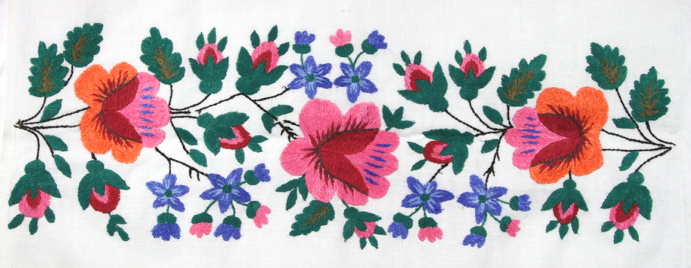Phytomorphic Motifs
Рослинні Мотиви
Phytomorphic Motifs
Рослинні Мотиви

The most common designs found on pysanky, and in Ukrainian folk art in general, are those associated with plants and their parts. Although pysankarky often depicted flowers, trees, fruits, branches, leaves and whole plants, they did so in a highly stylized fashion rather than a realistic one.
Such ornaments symbolized the rebirth of nature after winter, and thus life, growth, strength and renewal.
Below are brief descriptions of many Phytomorphic motifs and symbols. For more detailed information and examples of pysanky with these motifs, go to the corresponding pages in the Phytomorphic Motifs Gallery.
TREE OF LIFE/VAZON
The “tree of life,” is widely used in pysanky designs. It can be represented many ways. Sometimes, as is common in Hutsul pysanky, it appears as two deer on either side of a pine tree.

More often it manifests as a flower pot (“vazon”), filled with leaves and flowers. The pot itself is usually a rectangle, triangle or a rhomboid (symbolic of the earth), and is covered with dots (seeds) and dashes (water). Many branches grow out of it, in a symmetric fashion, with leaves and flowers. This plant is a berehynia (goddess) symbol, as the branches represent her (many) arms. It is reminiscent of the Christian Oranta with her upraised arms.

These are examples of traditional pysanky with a tree of life/vazon motif:
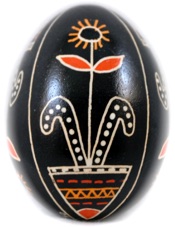


More examples of the vazon/tree of life and information about its symbolism here.
BRANCHES
Plants, like animals, were sometimes portrayed whole, but more often as their parts. Leaves or flowers were the most common manifestations, but plants could be represented as branches (hilky).
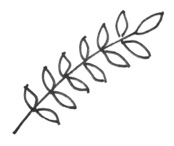
This is an example of a pysanka with a branch motif from the Sokal region (Korduba):

In the mountainous regions of Ukraine, pine or spruce branches were often depicted.

The evergreen nature of these plants meant they symbolized long life. These pysanky are from western Polissia; the spruce branches are quite evident in both the Binyashevsky illustration and my re-creation:


More examples of tree and their parts and information about symbolism here.
SOSONKA
In other regions, the sosonka was a favorite motif. It appears similar to a pine branch, but without and branching. The sosonka is the horsetail plant, the first greenery to appear in the spring. It is a symbol of spring, life, rebirth.
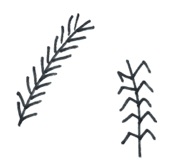

The pysanka on the left is an example of a sosonka motif, and is from the Lemko regions; it is an example of the drop-pull technique of pysankarstvo. On the right is a depiction of a ceramic pysanka from the tenth century; it also displays a sosonka motif, demonstrating the antiquity of this symbol.


More examples of the sosonka and information about its symbolism here.
“VERBA” PUSSY WILLOW
Pussy willow branches are sometimes depicted on pysanky; in Ukraine, the pussy willow replaces the palm leaf on Palm Sunday. They are depicted both with botanical accuracy and in a stylized form.

This is a motif which has gotten much more common on folk pysanky in recent years, particularly those of Pokuttia and Hutuslshchyna; examples of such pysanky:


More examples of pussy willow branches and information about their symbolism here.
LEAVES Plants could be represented on in whole or in part. Most often, it was only the leaves that were depicted. They were generally elongated, and could be simple or compound, smooth or faceted.
On pysanky, flowers can often look like leaves. The two are differentiated mainly by the fact that leaves are usually solid or divided in half; they often have a central oval or other rounded shape. Flowers have petals and are more compound structures. People unfamiliar with pysanka motifs often mistake leaves for flowers
This is an example of a simple leaf motif from Kherson:

There were several types of leaves that were distinct and named. Oak leaves were shown with wavy contours, and sometimes interspersed with acorns. In Ancient Ukrainian mythology, the oak and its leaves symbolize Perun, the god of lightning; to honor him, the Slavs burned fires of oak logs and branches. The oak carries his attributes: strength and power. These an examples of the oak leaf motif from Zaporizhia and Pokuttia:


More examples of the oak trees and acorns and information about symbolism here.
The clover or trylystok (three-leaf), with its characteristic shape, is commonly found on pysanky. Those from Podillia or the Kherson region use the first name. It is most commonly seen on pysanky from the Poltava and Middle Dnipro regions, where it is called the trylystok. These are examples of the trylystok from the Kyiv region (left) and Vinnytsia oblast (Podillia, right):


More examples of leaves and information about their symbolism here.
FLOWERS
Flower symbols are frequently found on pysanky, and fall into three general categories: vazony (flowers in a flowerpot, discussed above), ruzhi (or rozhi, eight petal flowers, discussed below), and other flowers. The first are a berehynia symbol; the second, sun symbols; the last group are discussed here.
Flowers are generally a symbol of beauty and of fertility and abundance.
The “other flowers” found on pysanky can also be subdivided. First there are the very widespread “kvitka” (flower) motifs. These are defined by their non-definition--there are no specific botanical features, it is a generic flower, not a specific one.
The second group is specific named flowers. In this group we see flowers which usually bear at least a passing resemblance to their botanical namesakes: carnations, bells, daisies, violets, sunflowers and others.
The third category is“exotic” flowers. These are usually given the names “tulipany” or “telepany” (tulips) or “orkhidea” (orchid). It was not so long ago that these plants were quite foreign to Ukraine, and few had ever seen them. These were fantastical names given to fantastical flowers, and the symbols usually bear no resemblance whatsoever to the named plants.
Lastly there are the Sokal florals. In the late 19th century two trends pushed changes in the pysanky of Sokal: a trend towards naturalism, along with the popularity of china painting. These two trends resulted in a specific floral style, sometimes isomorphic, and other times quite fantastical.
Selivachov has provided us with a great number of “”kvitka” motifs found on pysanky:

As you can see, flower motifs vary in size and shape, but have the common feature of a lack of specific features. They resemble a child’s conception of of a flower–petals, from a common center, often with a central disk, in various arrangements. It is the multiple petals which make a motif a flower.
More examples of flowers and information about their symbolism here: kvitky, named flowers, exotic flowers and Sokal florals.
RUZHA
One of the most popular motifs found on pysanky is the eight-pointed star, which is often called a “ruzha” or “rozha.” A ruzha is actually a mallow flower (hollyhock), although the term is applied, with modifiers, to many different flowers. Neither rozha nor ruzha refers to roses, as is often falsely assumed by diasporan Ukrainian speakers. The Ukrainian word for a rose (botanically speaking) is troianda (торянда).
The term rozha/ruzha is typically used for the large type of eight pointed star motif which is based on a circle, as opposed to the the smaller stars you often see in bands that are based on squares. The former more closely resembles a flower.
Marusia Chaika states that the ruzha/rozha is a solar symbol, especially when it is used as a large motif on two sides of an egg. When there are many small ruhzi on the surface of a pysanka, these may represent stars.
The term is also used for more floral appearing forms with rounded petals. Selivachov describes the “rozha” as usually being “a flower with eight petals, without any express botanical features,” and gives these examples of ruzha motifs (all but 1 and 3 are pysanka motifs):

These pysanky show classiC ruzha motifs. The example on he left is from Kholmshchyna; the one on the right is called «зелена рожа» (green rozha) and is from the village of Hubske in Poltava oblast, Lubenskyi raion.
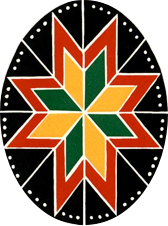

More examples of the ruzha and information about its symbolism here.
WHEAT
Neither stalks not heads of wheat are motifs found on traditional pysanky. I have seen thousands of traditional designs, and have yet to see a stalk of wheat on any one of them. I have seen sheaves of wheat on Lemko drop-pull pysanky, in a very stylized form. This pysanka is from Odarka Onyshchuk’s Symbolism of the Ukrainian Pysanka, and is from the Priashiv region (present-day Slovakia).
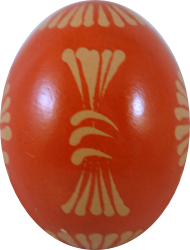
Wheat is a very popular motif in the diaspora, and can be seen in examples of diasporan embroidery, ceramics, paintings and flower arrangements. It is commonly seen on diasporan pysanky.
More examples of wheat and information about its symbolism here.
FRUIT
Fruit motifs, with the exception of grapes, are unusual on traditional folk pysanky. One exception, and a rare one at that, is this pysanka captured by Kulzhynsky from the village of Bilousivka, in Podillia (Tulchyn raion, Vinnytsia oblast). It has as its main motif plums:
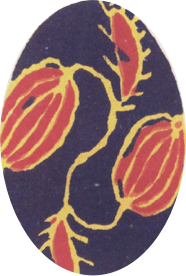
Other berries are sometimes seen. This lovely pysanka with birds and branches appears to have unidentified berries on the branches. It is from a private collection, and is probably from Pokuttia.
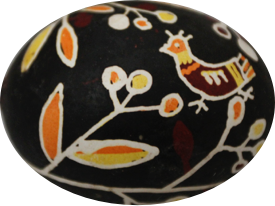
Grapes are probably the most commonly found fruit motif on pysanky; per Selivachov, this motif is found in just about every region of Ukraine, and varies from highly naturalistic to highly stylized. While this motif is more common on embroidery and pottery, it appears on pysanky as well. The motif consists of a compact grouping of rounded, faceted or even linear elements reminiscent of abundant bunches of grapes.
Whatever ancient symbolism there may have been to grapes and grapevines, they are now subsumed to christian ones. In the Christian context, the vineyard is Christ’s church, and the vine-grower is Christ himself; he is also the “True Vine.”
This pysanka, from Pokuttia, has what appear to be quite lovely grapes. The colors are not natural, and the shape stylized, but it fits the profile. It is from a private collection.
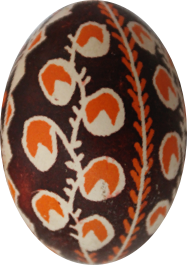
More examples of fruits and information about their symbolism here.
VEGETABLES
Vegetables are a rarity on pysanky. Even when motifs are given vegetable names, one cannot be sure if these are actual vegetable symbols, or names given later when the original meanings were lost. One that does show up occasionally is «Огірочки» (ohirochky, cucumbers). This is an example from Rivenshchyna (Vira Manko):
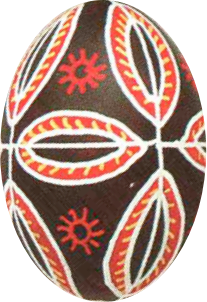
More examples of vegetables and information about symbolism here.
SEEDS
Although seeds are a plant part, they are more of an agricultural symbol, and are often found in conjunction with other scevomorphic symbols like plowed fields or rain clouds. Seeds were represented by dots or by tear-drop shapes. This is an example from Binyashevsky, from Pokuttia:
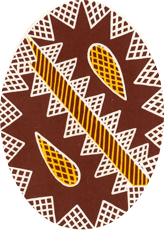
More examples of seeds and information about their symbolism here.
The rest is under construction. Check back later.
Back to MAIN Symbolism home page.
Back to MAIN Pysanka home page.
Back to Pysanka Index.
Search my site with Google
